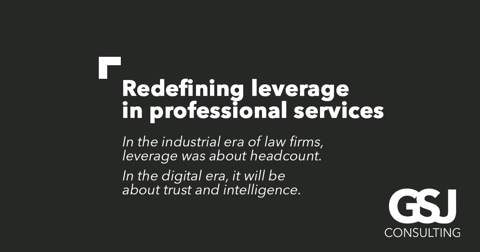Redefining leverage in the age of AI

Today: Leverage = Senior Partner Expertise x Junior Lawyer Labour
Tomorrow: Leverage = Human Trust x Machine Intelligence
For decades, “leverage” has been the heartbeat of law-firm economics. The word itself evokes an image of a pyramid structure: multiple junior lawyers supporting fewer senior partners, enabling firms to scale expertise into billable hours. In the traditional model, leverage meant Senior Partner Expertise × Junior Lawyer Labour.
But as the age of artificial intelligence (AI) dawns, this equation is being reviewed and rewritten. Tomorrow, leverage is going to be less about headcount ratios and more about a new dynamic: Human Trust × Machine Intelligence.
The traditional view: leverage and the billable hour
Ever since the billable hour became the dominant measure of pricing legal work, leverage has been the defining metric of profitability. A partner’s ability to generate revenue wasn’t only about their own billable time; it hinged on how effectively they could “leverage” a team of junior lawyers.
The classic pyramid structure of law firms reflected this logic. At the top sat a few senior partners bringing in clients, setting strategy and applying judgment. Beneath them were associates, clerks and graduates producing the bulk of the hours. The greater the base, the higher the profits at the top.
In this model, leverage was fundamentally about labour arbitrage: partners sold high-value expertise and associates produced the detailed, labour-intensive work at lower cost. The firm’s profitability was a function of how wide that ratio could stretch.
The AI disruption: machines enter the equation
Enter AI.
From document review and due diligence, to research, drafting and even predictive analytics, machines are now able to perform work that previously occupied armies of junior lawyers. What was once a labour-intensive process is becoming an intelligence-augmented one.
This isn’t just a matter of efficiency. AI changes the economics of legal service delivery. If a task that once required 100 hours of junior time can now be done in 10 minutes by an AI tool, the old leverage model collapses. Profitability can no longer be driven by scaling human hours.
Instead, the focus shifts to how firms integrate AI into their workflows, how they supervise it and, most importantly, how they build client trust in its use.
Redefining leverage: from labour to trust
The future equation looks more like this:
Leverage = Human Trust × Machine Intelligence
Why trust? Because in professional services, relationships and reputation remain paramount. Clients don’t pay for algorithms; they pay for judgment, accountability and assurance that their interests are being protected.
- Trust in the advisor: Clients want confidence that their lawyer understands context, nuance and strategy in ways no machine can replicate.
- Trust in the machine: At the same time, they must be persuaded that AI outputs are reliable, accurate and ethically deployed.
Firms that can combine both human oversight and machine efficiency will redefine what leverage means in practice.
The multiplier is no longer the number of juniors under a partner; it’s the strength of client trust multiplied by the sophistication of AI integration.
The new dimensions of leverage
- Speed as a value driver: Clients increasingly expect near-instant answers. AI enables faster turnaround, but it’s the lawyer’s role to filter, interpret and advise. The speed advantage becomes a form of leverage in itself, winning work by being more responsive.
- Scalability without headcount: Where the old model scaled through hiring, the new model scales through tools. Firms can handle more matters, across more jurisdictions, without proportionate increases in staff.
- Risk management as a differentiator: With machines generating work, the risk shifts from human error to machine error; or human misuse of machine outputs. Firms that build robust oversight, governance and ethical frameworks will enjoy leverage in the form of client confidence.
- Talent reimagined: Junior lawyers aren’t disappearing; their roles are evolving. Rather than spending years proofreading documents, they’ll need to develop skills in supervising AI, applying critical thinking and strengthening client relationships earlier in their careers.
Strategic implications for firms
The firms that thrive will be those that stop clinging to the old definition of leverage and start asking new questions:
- How do we use AI not just to cut costs, but to create new forms of value for clients?
- How do we maintain transparency about AI’s role in legal work without eroding client confidence?
- How do we retrain and reorient talent pipelines so that juniors gain the judgment and client skills that AI cannot replicate?
The winners will be firms that treat AI not as a threat to leverage, but as a catalyst to redefine it.
Conclusion: the leverage multiplier has changed
In the industrial era of law firms, leverage was about headcount. In the digital era, it will be about trust and intelligence.
Where yesterday’s equation read:
Senior Partner Expertise × Junior Lawyer Labour = Profitability
Tomorrow’s will read:
Human Trust × Machine Intelligence = Sustainability
The law firms that embrace this new formula will not only survive, but lead. The ones that don’t will discover that pyramids built on billable hours crumble quickly when the foundations of leverage shift beneath them.
Looking for more insights?
Contact GSJ Consulting
We can help you Aquire, Retain, Grow
The information contained in this article is of general nature and should not be construed as professional advice. If you require further information, advice or assistance for your specific circumstances, please contact us.
